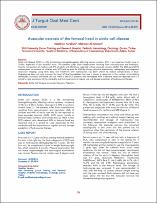Avascular necrosis of the femoral head in sickle cell disease
Künye
Karakurt, N., Deveci, M. A. (2017). Avascular necrosis of the femoral head in sickle cell disease. İnönü Üniversitesi Turgut Özal Tıp Merkezi Dergisi, 24(1), 79-80.Özet
Sickle cell disease (SCD) is a life threatening hemoglobinopathy effecting various systems. SCD is an important health issue in Turkey, especially in the southern areas. The patients suffer from complications resulting from vaso-occlusion and hemolysis. Twenty- two percent of children and 49% of adults with Hb SS are reported to have avascular necrosis (AVN). The SCD panel 2014 recommends to evaluate all children with SCD and hip pain for AVN by history, physical examination, radiography and magnetic resonance imaging. Long term daily oral treatment with hydroxyurea has been shown to reduce complications in SCD. Hydroxyurea does not only increase the level of fetal hemoblobin but also it causes a reduction in the number of circulating leukocytes, increases red blood cell size. Here in two SCD patients who developed AVN in femoral head are reported and it is aimed to raise awareness to this morbidity and the importance of regular use and dosage escalation of hydroxyurea therapy.


















